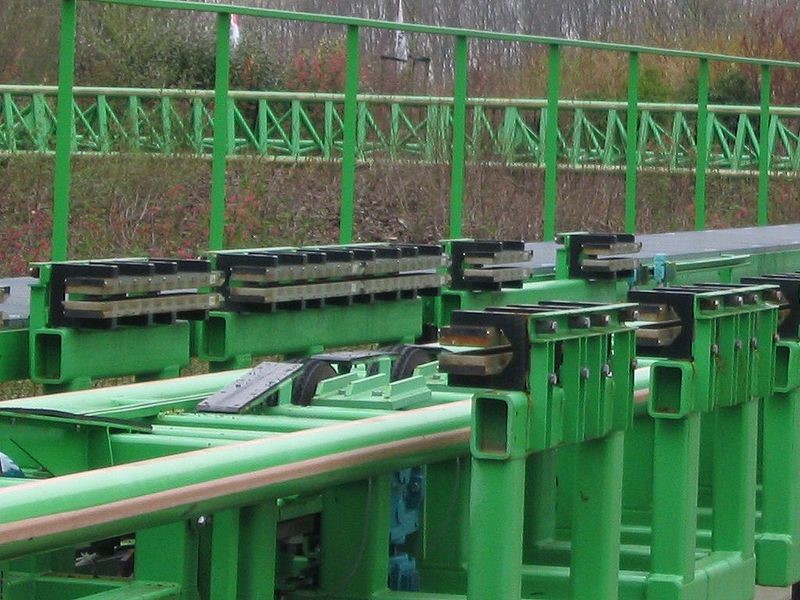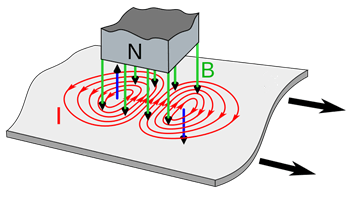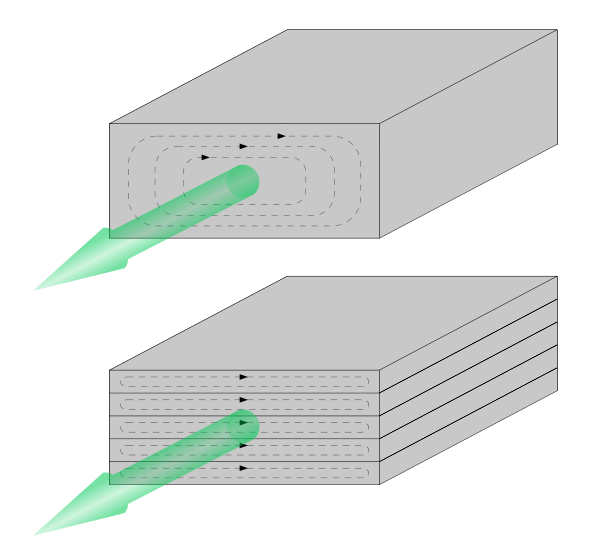Eddy
currents are currents which circulate in conductors like swirling eddies in a
stream. They are induced by changing magnetic fields and flow in closed loops,
perpendicular to the plane of the magnetic field. They can be created when a
conductor is moving through a magnetic field, or when the magnetic field
surrounding a stationary conductor is varying i.e. anything which results in
the conductor experiencing a change in the intensity or direction of a magnetic
field can produce eddy currents. The size of the eddy current is proportional
to the size of the magnetic field, the area of the loop and the rate of change
of magnetic flux, and inversely proportional to the resistivity of the
conductor.
Like any
current flowing through a conductor, an eddy current will produce its own
magnetic field. Lenz’s Law states that the direction of magnetically induced
current, like an eddy current, will be such that the magnetic field produced will
oppose the change of magnetic field which created it. This resistance created
by the opposing magnetic fields is exploited in eddy current braking, which is
commonly used as a method of stopping rotating power tools and rollercoasters.

In the
diagram below, the conductive metal sheet (representing the moving
rollercoaster car or power tool for instance), moves past a stationary magnet. As
the sheet moves past the left edge of the magnet, it will feel an increase in
magnetic field strength, inducing counter-clockwise eddy currents. These
currents produce their own magnetic fields and according to Lenz’s Law, the
direction will be upwards i.e. opposing the external magnetic field, creating
magnetic drag. At the other edge of the magnet, the sheet will be leaving the
magnetic field and the change of field will be in the opposite direction, thus
inducing clockwise eddy currents which then produce a magnetic field acting
downwards. This will attract the external magnet, also producing drag. These
drag forces slow the moving sheet, providing the braking. An electromagnet can
be used for the external magnet, meaning it is possible to vary the strength of
the braking applied by adjusting the current through the electromagnet’s coils.
An advantage of eddy braking is that it is contactless, so results in no
mechanical wear. However, eddy braking is not suitable for low speed braking and
because the conductor has to be moving, eddy brakes cannot hold objects in
stationary positions. Thus, it is often necessary to also use a traditional
friction brake.

Eddy
currents were first observed in 1824 by scientist and then Prime Minister of
France, François Arago. He realized that it was possible to magnetize most
conductive objects and was the first to witness rotary magnetism. Ten years
later, Lenz’s Law was postulated by Heinrich Lenz, but it wasn’t until 1855
that the French physicist Léon Foucault officially discovered eddy currents. He
found that the force needed to rotate a copper disk when its rim is placed
between the poles of a magnet, such as a horseshoe magnet, increases and the
disk is heated by the induced eddy currents.
The heating
effect originates from the transformation of electric energy into heat energy
and is used in induction heating devices, like some cookers and welders. The
resistance felt by the eddy currents in a conductor causes Joule heating and the
amount of heat generated is proportional to the current squared. However, for
applications like motors, generators and transformers, this heat is considered
wasted energy and as such, eddy currents need to be minimized. This can be
achieved by laminating the metal cores of these devices, where each core is
made up of multiple insulated sheets of metal. This splits the core in many
individual magnetic circuits and restricts the flow of the eddy currents
through it, reducing the amount of heat generated through Joule heating.

Eddy
currents can also be removed by cracks or slits in the conductor, which break
the circuit and prevent the current loops from circulating. This means that
eddy currents can be used to detect defects in materials. This is called
nondestructive testing and is often used in airplanes. The magnetic field
produced by the eddy currents is measured, where a change in the field reveals
the presence of an irregularity; a defect will reduce the size of the eddy
current, which in turn reduces the magnetic field strength.
Another
application of eddy currents is magnetic levitation. Conductors are exposed to
varying magnetic fields which induce eddy currents within the conductor and
produce a repulsive magnetic field, pushing the magnet and conductor apart.
This alternating magnetic field can be caused by relative motion between the
magnet and conductor (generally the magnet is stationary and the conductor
moves) or with an electromagnet applied with a varying current to vary the
magnetic field strength.